|
This site is primarily for young string players; but since
much of the joy of learning an instrument is in making music with others the site aims to
provide opportunities to play not just with fellow stringsters but also to join in with
singers, recorders (and other wind instruments) and also percussion.
There are three distinct sections below:
row one - specifically teaching material for young violin
and viola pupils - but with something for cellists too!
row two - providing occasions to join in classroom work and school assemblies with
other instrumentalists and singers
row three - string orchestra and ensemble work with additional parts for recorders
and percussion
and not forgetting:- Footsteps
in row four - a good introduction to chamber music, about grade seven, and versions for
horn trio and also piano trio - including options for ’cello or viola!
+ La Senerata by Gaetano Braga - again versions for horn trio and also
piano trio
- nor theTelemann Canon Sonata in row five - with versions for 2 violins and 2
two violas - or even for violin and viola!
There are scores to download, and also recordings, with both parts sounding and also with
one line muted.
| The 42 'workshop' studies
for technique owe much to the influence of the great American teacher Paul Rolland, and
seek first and foremost to encourage a relaxed and uninhibited posture with both left and
right arms moving freely and easily around the violin. Intonation is stressed, both
through the early use of harmonics, and by the regular part-playing wich is a built-in
feature of the scheme since the studies combine with a similar number of progressive
'melody-time' tunes. They first appeared in print in June 1982 as an appendix to my
1980-81 Associateship Report for London University's Institute of Education: "Aims
and Methods in Group Instrumental Teaching with particular Reference to Strings, and its
place within the General School Curriculum." To
these '42 Moments' were later added a range of complementary and at times highly original
worksheets, (see also Images and Imagination) which include, interspersed
thoughout the book:
* Creative Writing Sheets (3) * Rhythm-Swap Sheets (3)
* Treble/Alto Switch Sheets (3)
*Pentatonic, Position and Chord Work,
together with a supplementary series of 'Tail-Piece' melodies and
scalework to complete each page-long block of work. Depending upon the circumstances
these should take between two and four weeks to complete and as a guide to progress the
date of introducing each new topic should be faithfully recorded on the back cover
practice chart.
Some of these topics are also covered in the Images and Imagination
pack; but in addition that also has pages headed, Spiccato-Tap (1), Slurs - the buoyant
elbow (2) and Feeling the Harmony (2)
- and something especially for cellists: a new pack of Bass / Tenor Switch Sheets
(3)
The Position Pack has four pages for violin and another four for viola.
The scheme is conceived as a three to four-year course for children
being taught in groups, starting at second year junior. It assumes that the various
points of the lesson will always be introduced by the teacher, and includes a
'talking-point' section to reinforce what has been said in the class, and also to stress
the need for revision of earlier material (sometimes with a new objective in mind) -
another important aspect of the book.
Children who elect to proceed further with their instrumental studies
should find they have acquired secure foundations for that invaluable combination of sound
technique and musical awareness; but it is at least as great a concern that those children
for whom this course will represent the limit of their instrumental involvement will
equally have gained a worthwhile and enriching experience, both musically and
educationally. (This introduction dated June 1987) |

|

|
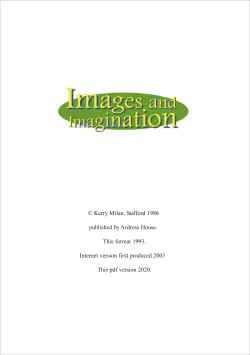
|

|
<<view
/ downoad 42 Moments>>
|
<<view
/ download Viva Viola>> |
<<view / download Images
& Imagination>>
<<ditto
commentary>>
Available now - "Riding the Bass / Tenor Switchback" |
<<view
/ download Position Pack>> |
There are over a hundred classroom and assembly pieces included in these
four collections, which all include sound files, full performance and also melody lines
with the appropriate accompanying violin parts. When they were first published,
there were also accompanying cassette tapes! These, and some of the addresses
listed, have obviously disappeared over the years!
|

|

|
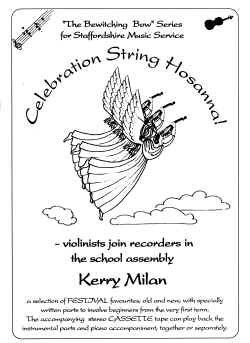
|
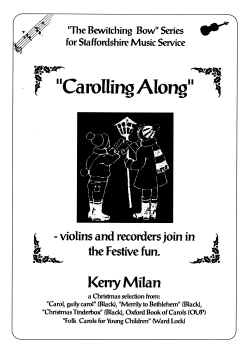
|
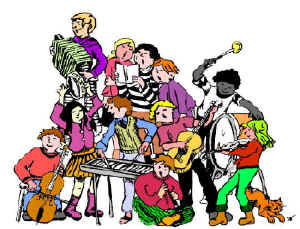
<<view
/ download Sing & Play Along violin>>
<ditto
viola>> <<ditto
cello>> <<ditto
vocal>>
<<ditto
words & piano>> <<ditto
percussion>>
There is also a dedicated website for Sing and Play
Along which has not only the pdf files listed above, but also melody parts for flute,
clarinet, alto saxophone and trumpet as well as sound files for all 28 songs.
visit the
"Sing
and Play Along"![[EXTERNAL]](images/leave-site.gif)
site.
For some reason to do with missing codexes
these sound files don't play using Microsoft Edge - other browsers are fine - as at October 2020 |
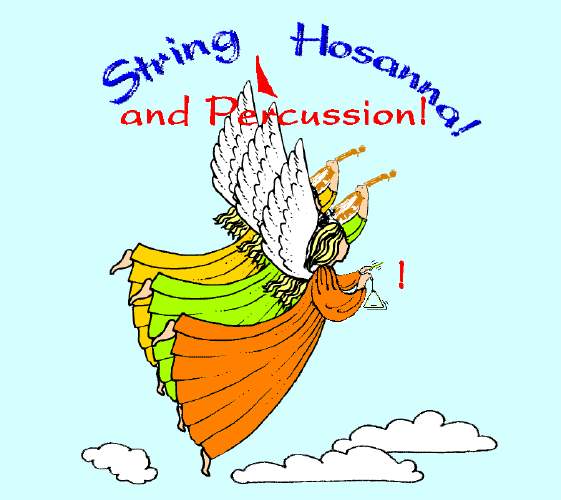
<<
view / download String Hosanna violin>>
<<ditto
String Hosanna viola>>
<<ditto
String Hosanna percussion>>
There is also a dedicated website for String and
Percussion Hosanna! which has not only the pdf files listed above (10 pages of violin
music, 10 pages for viola, and 13 for percussion) but also recordings of all 26 assembly
favourites.
There are also audio clips of individual
parts. These are small midi files which my browser downloads when clicked. Click the
downloaded file and it plays, and if media player is minimised the music can be read at
the same time!
visit the
String
& Percussion Hosanna!![[EXTERNAL]](images/leave-site.gif)
site.
For some reason to do with missing codexes
these sound files don't play using Microsoft Edge - other browsers are fine - as at October 2020 |

<<ditto
Celebration String Hosanna Violin>>
There is also a dedicated website for Celebration
String Hosanna!
There are recordings of 29 songs and carols - Spring,
Pancake Day, Lent/Easter, Harvest/Autumn, Halloween/Guy Fawkes, Endings, Hindu and Jewish
- for festival assemblies throught the year.
There are also audio clips of individual
parts. These are small midi files which my browser downloads when clicked. Click the
downloaded file and it plays, and if media player is minimised the music can be read at
the same time!
The melody parts are suitable for recorder, violin, flute etc, while the accompanying line
is specifically for young violinists.
visit the
Celebration
String Hosanna! ![[EXTERNAL]](images/leave-site.gif)
site.
For some reason to do with missing codexes
these sound files don't play using Microsoft Edge - other browsers are fine - as at October 2020 |

|
<<view
/ download Carolling Along violin>>
<<ditto
viola>> <<ditto
cello>>
<<ditto
piano>> <<ditto
percussion>>
There is also a dedicated website for
Carolling Along
As well as the above files, there are also parts for flute, clarinet,
trumpet and E flat sax. A simple percussion score is also included, with short,
memorable parts for a variety of tuned and untuned percussion, which can even be listened
to individually, simply by clicking on an instrument's name.
In response to many requests, a piano accompaniment book was also
published, with new accompaniments by me to the 21 carols.
visit the Carolling Along![[EXTERNAL]](images/leave-site.gif)
site.
For some reason to do with missing codexes
these sound files don't play using Microsoft Edge - other browsers are fine - as at
October 2020 |
In 1995 I was asked to provide music for a large gathering of schools in Stafford,
which I remember included Jonah-Man Jazz Cantata, I Do Like to be Beside the
Seaside, Don't Dilly Dally and even audience participation for Pack Up Your
Troubles / Tipperary! I think the Finale was Chitty Chitty Bang Bang
for which Stuart Johnson had done an arrangement. The seven pieces here are
arrangements of Daisy Bell, The Keeper and Offenbach's Galop, and then
in Island Trundle four folk songs, Ye Banks and Braes, My Aunt Jane, The Ash Grove
and The Drunken Sailor.
|
The final arrangement here,
the Donauwellen Waltz, was made for a rather
different occasion. Staffordshire County Council music department at one glorious
period had almost a hundred full-time peripatetic instrumental music teachers, who taught
their instruments for four days each week, but who played in ensembles on Fridays, giving
concerts each year to every school in the county, from small village schools up to the
largest comprehensives.
Sometimes these were small chamber ensembles, at other times full orchestras, while at
other times we went out in larger ensembles such as string orchestras and it was always a
joy when some of a school’s pupils could join in for some of the items.
Josef Ivanovici’s Donauwellen Waltz was
just one of a number of such works we would take into a school, with recorder and
percussion parts having been sent on ahead earlier.
It truly did mean that the instrumental service reached all the county’s pupils, and
every year too. The Donauwellen Waltz was
especially arranged in 1991 and happily performed in schools throughout the Stafford and
Cannock areas during 1991 and 1992, the catchy melodies being passed around the orchestra
from one section to another. |

The photograph, which has just come to light after nearly
30 years, shows a very happy team, from a different world now, with our "Strings and
Things" programme including the newly arranged Donauwellen Waltz. |

|

|
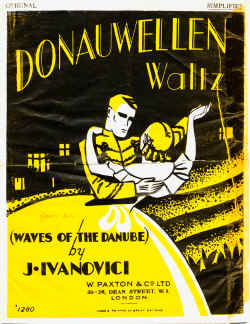
|
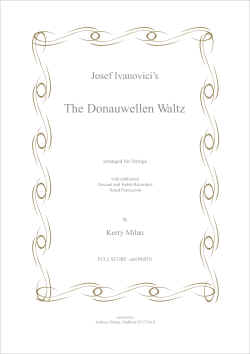
|
<<view /
download junior pack score & parts>> |
<<view/download
Island Trundle score/parts>> |
<<hear
the Donauwellen Waltz arrangment>> |
<<view / download donauwellen
score and parts>> |
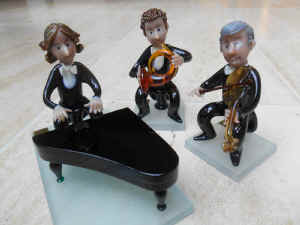
|
One other piece worth mentioning at this point is a horn trio - horn, violin and piano -
written with my grandchildren in mind, called Footsteps.
It is about grade 7 technically, and not too daunting musically either, and makes a good
introduction to the world of chamber music. Based on a song I wrote in 1997 telling
of one young woman's feelings after the death of her partner following depression its
haunting memories vie with a sense of despair and desolation. Again the music can be
downloaded for free and the violin part also has an alternative flute version. As at
June 2020 because of the coronavirus Lockdown I have not seen the grandchildren to
record the piece; but you can get a good idea of the work from this computer-generated
recording: <<<Listen to Footsteps>>>.
And here are the parts: <<< Download the Footsteps parts>>>
And Stop Press on 14 July 2020 - a version of Footsteps for
piano trio
- hear it now <<Footsteps piano trio>>
<<Download
the parts>>
Brahms of course was very much against his horn trio being arranged with cello; but was
happier with the viola, and so I have also included a viola part!
|

|

|
In similar fashion, December
2020, I have now re-scored Gaetano Braga's famous Serenata for Horn trio as well
as re-type-set my original piano trio version from 1928! Gaetano Braga, born
1829, died 1907 in Milan, was an Italian composer and cellist whose work includes two
cello concertos, a quartet, a quintet and various cello/piano compositions, and no less
that eight operas.
He is perhaps most famous now for La Serenata, a dialogue (a bit like that in Erlkönig)
between an anxious mother and her daughter who hears an angel calling her. And in the end the girl does follow the
angel’s voice. Originally, the narrator
took the part of the mother and her daughter, with the angel’s voice represented by a
violin or cello, who was instructed to play “off-stage” from the singer to give
a more ephereal effect. Sometimes actually called the “Angel’s Serenade”
the piece has been recorded in English by tenor John McCormack and Fritz Kreisler and also
by Jan Peerce and Mischa Elman, not to mention recordings in Italian and in German
(Richard Tauber). (Information courtesy of
Wikipedia, Dec. 2020)
My old copy of this music is dated 1928, no. 89 in Banks’ Sixpenny
Edition, arranged as a piano solo with violin and cello ad lib parts. In May 1989 Stafford
Music Centre celebrated Staffordshire County Council’s centenary with “Two Grand
Vocal and Instrumental Concerts” at Stafford’s splendid Stychfields Hall (now
long gone). Supper was served between the
concerts and a “Supper Tape” was recorded to be played during the meal, produced
by a number of music centre colleagues, including the two who recorded the Braga Serenata
with me, Roger Siddall, cello and Caroline Robertson, pianoforte. It is this arrangement, by Louis Finch, that is
retype-set here and which was used for our 1989 recording.
And having recently arranged my own A Rapture Suite horn trio for piano trio, it
occured to me that I might here reverse the situation and set the “Angel
Serenade” as a horn trio, which I could then perform with my talented grandchildren. So here it is, in this format dedicated to my dear
wife Patricia as she too prepares to follow her angel.
Kerry Milan, Stafford, December 2020. |
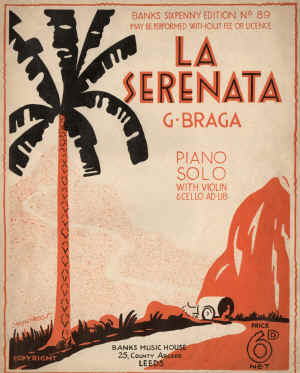
<<play the
1989 "Supper Tape" piano trio>>
<< play the new horn trio scoring>>
<<download the piano trio
parts>>
<<download the horn trio
parts>> |
VIOLIN VERSON
Both parts sounding
There are three movements, Vivace, Adagio andAllegro.
The first movement comes with a choice of two tempi, either crotchet = 130, or 138.
The Adagio is quaver = 66
The Allegro is crotchet = 104
<<play
Vivace=130>>
<<play
Vivace=138>>
<<play
Adagio>> <<play Allegro>> |
Telemann Canon Sonata
no. 1 in G major
for two violins or two violas.
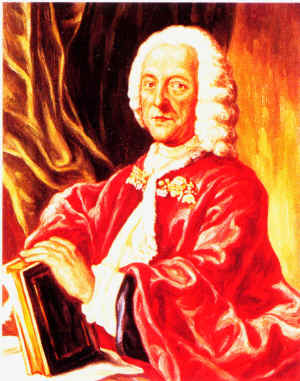
<<Download parts
here>>
- and remember, it also works for violin and viola! |
VIOLA VERSON
Both parts sounding
There are three movements, Vivace, Adagio andAllegro.
The Vivace is crotchet = 130
The Adagio is quaver = 66
The Allegro is crotchet = 104
<<play
Vivace=130>>
<<play
Adagio>> <<play Allegro>> |
Just the first part sounding
<<play
Vivace=130>>
<<play
Vivace=138>>
<<play
Adagio>> <<play Allegro>> |
Just the first part sounding
<<play
Vivace=130>>
<<play
Adagio>> <<play Allegro>> |
Finally, a very brief mention of some of my music
for professional stringsters!
Pippa Passes - five songs of Asolo is a work for Mezzo
Soprano and Piano Trio. Pippa Passes was by Robert Browning, first
published in 1841. These settings were recorded at All Saints Church East Finchley
in 2010 by Yvonne Howard and the English Piano Trio, Jane Faulkner, Justin Pearson and
Timothy Ravenscroft.
More information on the <<Pippa Passes![[EXTERNAL]](images/leave-site.gif) >> site >> site
Violin Sonata in A minor "Affinities" - rather
difficult; but brilliantly recorded by Jane Faulkner and Timothy Ravenscroft -
This is a substantial work at some 28
minutes, and should be a welcome addition to today's repertoire.
For both players the parts lie well,
but the work is not without challenges, not the least of them rhythmical. It
is a very satisfying and rewarding work - the whole work having been conceived as an
emotional journey, from the violinist's first anguished cry to the last movement's idyllic
happy ending.
Eight sample score pages are included
in a pdf document. You may also be interested in the notes that accompany the
printed score. Just click to follow the links:
<<sample pages from the piano score>>
<<composer's note>>
"I am thoroughly enjoying
playing it .... the whole sonata is really elegant and happy and characteristic of the
composer" !! - a dear colleague who shall remain
anonymous!
- see also the separate coverage
about Jane and Timothy and listen to the third movement Scherzando. 
String Quartet in A minor "Echoes". Following
on from Stafford Music Festival's premičre of Pippa Passes in 2011 I had a request for a
string quartet "with some kind of Greek idea behind it, or a Shugborough-related
theme" to tie in with plans to celebrate its importance in the story of the Greek
Revival and the 18th century's fascination with all things Asia Minor. A minor,
then, for the key! And an Aeolian theme. The first performance was at
Shugborough in June 2012 by the Alard Quartet, who then recorded the work at a concert at
St Mary's Stafford the following year. The final minutes of this performance can be
heard here: <<listen to final
section>>and sample pages can
also be viewed here: <<Echoes
pages>>. The full performance can be viewed on the vimeo
channel: <<"Echoes"![[EXTERNAL]](images/leave-site.gif) >>
with some dazzling playing by Nigel Stubbs. >>
with some dazzling playing by Nigel Stubbs.
A Rapture Suite - a tone poem for Horn Trio The five
movements are based on the music of the Rapture Song Cycle, which comprises
settings of twenty of the poems by the then poet laureate Carol Ann Duffy, part of a
collection of 52 poems called Rapture. Like the song cycle the Rapture
Suite uses serial technique throughout. The work was scheduled for recording in
September by a splendid Scottish trio, the brilliant pianist Scott Mitchell, Christopher Gough, principal horn with the Royal Scottish
National Orchestra and Maya Iwabuchi, leader of the Royal Scottish
National Orchestra since 2011, her playing described in The Strad as "simply
brilliant" and in the Times as "gorgeous".
-and new October 2020 - a version of the Rapture
Suite tone poem for Piano Trio - details with the Horn Trio.
And this brings us neatly back to the top of this page, with its
link to the Horn Trio's own dedicated pages, including sound samples and background notes.
Sadly the music, in print and / or download form, for these
last four works is no longer available from the splendid classical music site tutti.co.uk
which is now closing down.
Nor are the accompanying audio CDs.
Kerry Milan, March 31st 2025, Stafford
Further information about the recordings, and digital scores
in pdf format are available from ardrosshouse@btinternet.com
|